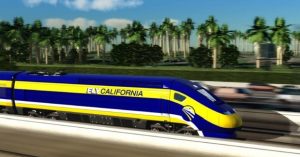The on-going story of California’s ambitious and controversial high-speed rail project is a tale of two trains.
To hear High Speed Rail Authority’s Chief Executive Officer Brian Kelly tell it, high-speed rail is a transformative endeavor that will propel California into a carbon-free future at 220 miles per hour while creating jobs, economic stimulus, and sustainable communities along the way.
To a growing army of critics, it’s a boondoggle of historic proportions that could cost the state up to $100 billion or more while failing to fulfill promises made to California voters who approved the project 10 years ago. As cost estimates have doubled and delays have put the project eleven years behind schedule, many are wondering if it will ever be completed.
It’s also a project that receives an ongoing 25 percent cut of California’s Greenhouse Gas Reduction Fund (GGRF) – more than $2 billion to date – leaving environmental-justice advocates scrambling each year to fund needed projects that reduce pollution in low-income and disadvantaged communities hit hardest by environmental degradation.
None of the five programs prioritized for GGRF money this year by Coalition for Clean Air and our partner organizations received the full amount we requested. In fact, the programs to address poverty and pollution were slashed by nearly 30 percent from last year’s funding. Community groups say that what their residents need is better local public transit to get them to and from work and school.
High-speed rail in California got rolling in 2008 when voters approved Proposition1A, giving the project a $9.9 billion down payment on what was then an estimated $40 billion price tag.
When and if completed in 2033, passengers are expected to be whizzed in zero-emission trains from Los Angeles to San Francisco in 2 hours and 40 minutes. The cost of a ticket is now estimated at $93, up from the initial $55 sold to the voters.
CEO Kelly says high-speed rail will entice people out of their autos and airline passengers to get on board, preventing 1.5 million metric tons of carbon from entering our air. That’s like taking 330,000 cars off the road, he says.
The Authority’s commitment to using 100 percent renewable electricity to power the trains is impressive and significant.
Kelly makes a good case for the sustainability benefits to California of a high-speed rail system that is integrated with upgraded regional rail networks. And we know that bullet trains have succeeded for decades in places like Japan and Europe.
But where the money will come from to complete the project remains a mystery. It’s supposed to come from a combination of federal, state and private sources but the Republican-controlled Congress and President Trump are cool to the project and private investors are skittish.
Construction is underway in the San Joaquin Valley where more than 2,000 workers in five counties are building viaducts, pillars and overpasses along a 119-mile section of track from Madera to Bakersfield.
At a recent round-table for environmental organizations, Kelly and his team of high-speed rail officials previewed the Authority’s 2018 Sustainability Report to highlight the project’s economic and environmental benefits so far.
The report covers everything from job creation (30 percent of all new jobs in the Fresno area are high-speed rail), to economic output ($5.1 billion to $5.9 billion), to reduction in diesel emissions from construction (only using less-polluting on and off-road equipment), to tree plantings, to natural habitat preservation (2,500 acres) and more.
The report claims the bounty is reaching disadvantaged communities where more than half of all project expenditures have occurred and where 115 of the 427 small businesses under contract by the Authority are located.
Kelly would rather the critics focus on what the authority has done rather than the cost overruns, blown schedules and a funding gap that poses a serious threat to the project’s future. If ticket prices continue to escalate and projected ridership – currently at 36.2 million annual passengers by 2033 – fails to materialize the promised environmental benefits will certainly fall short.
“There’s no shortage of challenges on this project,” Kelly concedes, adding that it’s the largest infrastructure project in the nation. The kind of set-backs suffered so far are not unusual for a project of this scale, he added.
Maybe, but as high-speed rail rolls down the tracks of uncertainty it’s burning through billions of dollars in greenhouse gas reduction funds that might do more good supporting proven programs to improve the health and quality of life of those in underserved communities.
[share title=”Share This Post”]








